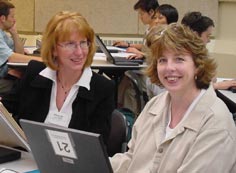Description of Task:
Pre-speaking/listening activities:
Students, in groups of three, will receive a handout (see Attachment
1) with a list of terms in French for vital statistics equivalent to
"infant mortality rate," "fertility rate," "death
rate," "population under 15 years," etc. in English.
Using their knowledge of cognates, students will try to decipher these
terms and identify to what they refer overall. As a class activity,
groups will report their understanding of each term. Because some students
may not have encountered these terms in English and may have no sense
of their meanings, the teacher should allow sufficient time to explore
the meanings of these terms in English, what they measure and how they
work (e.g., per thousand, percent, etc.). Once students seem to have
a grasp of the meanings, the teacher should reinforce pronunciation
of the terms so that students can readily use them in the following
partner/information gap activity.
The teacher provides a review of quel
in forming questions. The teacher will direct students to determine
which form of quel they will use to form questions
related to the demographic statistics. Individually, students
will write on their list of French terms, the form of quel they
would use with each term. Since the terms are not preceded with
gender indicators,
the teacher may want to do a quick review to determine noun gender
(e.g., -ion ending is generally feminine, adjective endings
may provide a clue, etc.) Students will finish each question so that
in the end, they will have a complete list of questions in French: "What
is the population?" (Quelle est la population de Sénégal?)
"What is the rate?" (Quel est le taux?).
To assess this activity, the teacher can walk through the class and
check each student's work.
Speaking/listening during activities:
Information Gap Activity:
Students should now be ready to perform the following partner/information
gap activity (see Attachments 2A and 2B). For this task, each student
will have half the statistics and ask his/her partner for information
that s/he needs. The teacher should model the first question/answer
(Quelle est la population du Sénégal?).
Once students have filled in their sheets, partners should check
to
see that each other's work is correct. In the end, each student
will have a column filled with vital statistics related to Senegal.
Returning
to the group setting, as an oral review and check of numbers,
the teacher may ask individual students Quel est le produit
national? and so on.
Listening Comprehension Activity:
Now the teacher will direct students to the third column on Attachments
2A and 2B in which they will fill in statistics related to the United
States (provided on Attachment 3). The teacher may first begin by having
students predict the statistics for selected categories. Then the teacher
may approach this activity as a means of checking oral comprehension
of numbers by dictating the statistics for each term.
The teacher may collect these sheets and correct them
for use with the following day or s/he may choose to have students exchange
papers. With a contrasting color of pen, these student "evaluators"
will make sure each number is correct. The teacher may then quickly
scan the sheet to see how well each student did on the oral comprehension
exercise. In the end, each student will have all of the statistics for
both Senegal and the United States and s/he is now in a position to
compare and contrast the two countries.
Post task:
Looking at the statistics for both Senegal and the United States, students
are able to answer the questions related to these facts and what they
mean. In groups of three, students will respond to assigned questions,
some of which reflect basic facts, and some of which require more thought
and deduction based on the facts (see Attachment 4).
Each group should assign a "recorder," who is
responsible for taking notes of the group-generated responses. Another
student is given the role of "reporter" and is responsible
for reporting the group's ideas and opinions to the whole class. The
third student in each group is the "task facilitator," whose
job it is to keep the group on task so that all questions are addressed.
The teacher may choose to assign different questions to
different groups, or assign all of the same questions to all groups.
Once students have responded to these questions, they have a base for
further conversation and discussion. Based upon their responses, they
may make some deductions about Senegal and its people (At this point,
the lesson may move on into consideration of the country through computer
images, slides and photos where students will see that this country
is more than "just numbers.")
Assessment:
Much of the assessment is built into these tasks with the teacher making
consistent and informal checks of learning for each group, partner,
and individual. The teacher may want to collect and grade the numerical
dictation of statistics related to the United States for a comprehension
check. For the final question activity, the teacher can collect the
responses to the questions (as recorded by each group); s/he may also
select a number of questions to evaluate; for example, questions 5,
8, 13, 14, and 15 emphasize the comparison between Senegal and the United
States.

